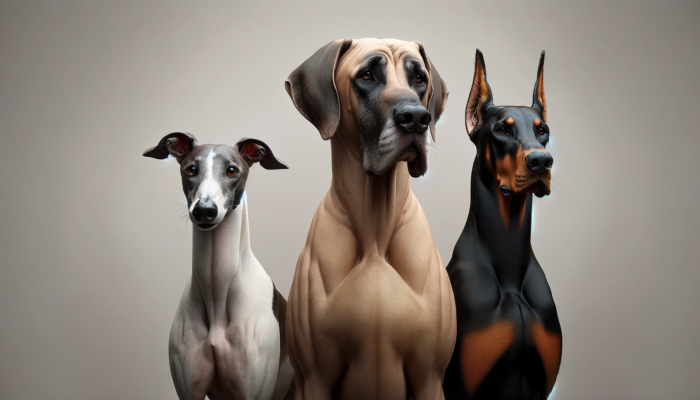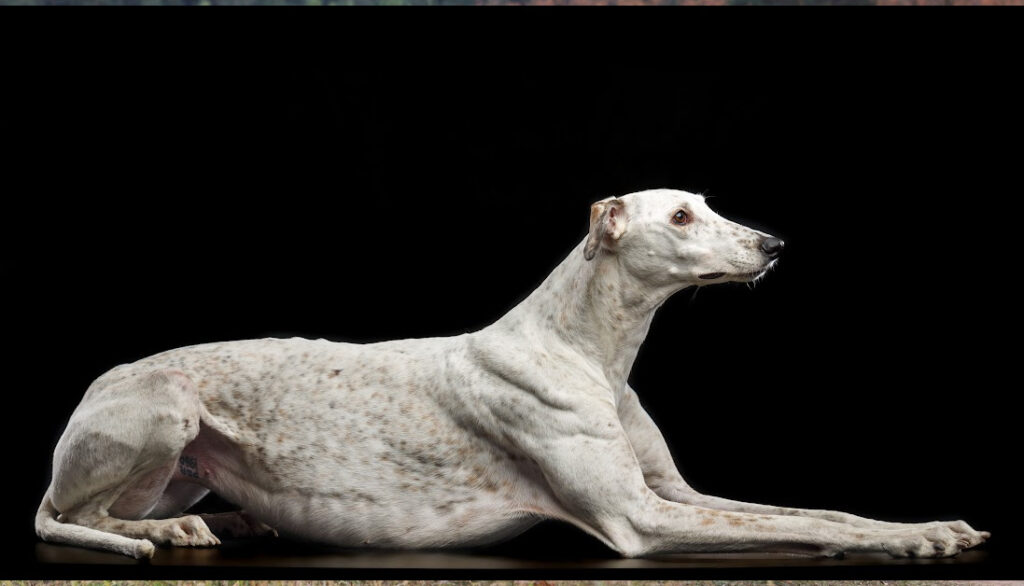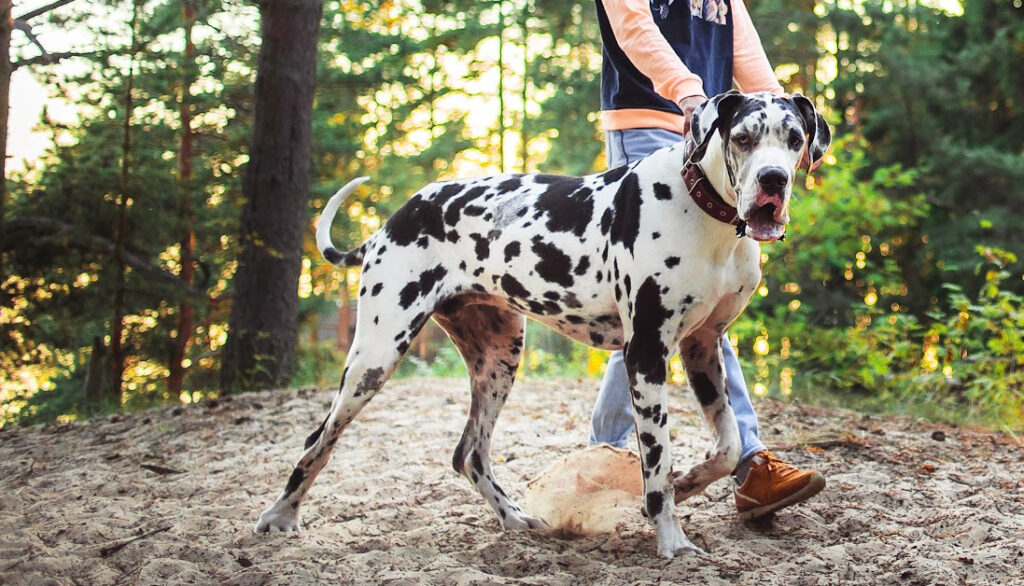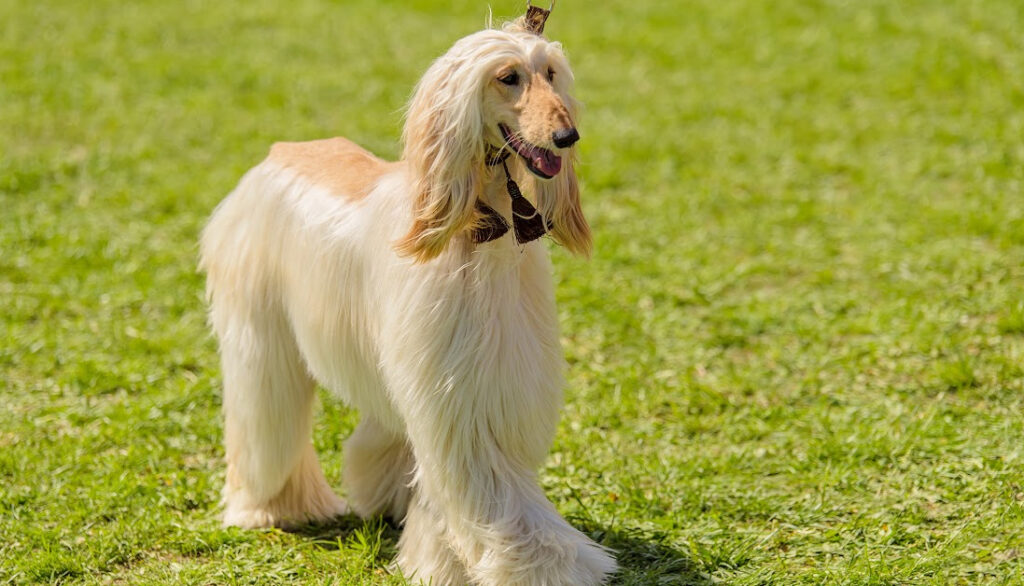Are you intrigued by those high-stepping beauties prancing around the dog park? Welcome, fellow dog lover, to the world of long-legged dog breeds. These tall canine companions possess a unique charm, a combination of elegance, speed, and a magnetic pull that’s hard to resist. From the sleek, well-muscled Greyhounds to the majestic stature of the Great Danes, each breed has its individual traits and attributes.

In the canine kingdom, long legs aren’t just about physical appearance. They’re a reflection of our furry friends’ fascinating evolution and history. These towering breeds were often developed for specific roles such as hunting, herding, or racing. Their long limbs give them speed, agility, and a notable advantage in performing their tasks.
But there’s more to these breeds than their job description. Owning a dog breed with long legs often means sharing your home with a high-energy, active, and agile companion. Picture yourself embarking on brisk morning jogs, engaging in stimulating play sessions, or even participating in dog sports such as agility or flyball. Their height also comes with a few health considerations, requiring regular checkups and preventative care.
Despite their size, many of these long-legged breeds have a gentle, loving nature. With the right training and socialization, they can make confident, well-behaved companions. So, whether you’re drawn to the Sight Hounds like Afghans, Borzois, and Salukis, or prefer the working dogs such as Dobermans, Irish Wolfhounds, and Standard Poodles, there’s a long-legged breed to suit any dog lover’s taste.
Let’s take a closer look at dog breeds with tall legs, delving into their unique characteristics, history, health considerations, and care requirements. We’ll also share some tips on training and socializing these high-steppers, preparing them to become confident, happy companions at home or at the dog park.

History and Evolution of Long-Legged Dogs
Delve deep into the fascinating world of long-legged dogs and discover the unique journey that has shaped these towering creatures. Unearthing the secrets behind their high-stepping gait and tall stature, we’ll traverse through time to gain insights into these remarkable breeds’ ancestry and modern evolution.
Ancestral Traits and Adaptations
Giants of the dog world, long-legged breeds have been carefully selected and bred for their towering stature and lengthy limbs over generations. But did you ever wonder why? The secret lies in their ancestral traits and adaptations.
Long-legged dog breeds have their roots in ancient times. Many were developed for specific tasks that required speed, endurance, and agility. For instance, the Greyhound, one of the dog breeds with the tallest legs, was bred to chase game, utilizing its long legs for swift and efficient movement. Similarly, the Irish Wolfhound, another towering breed, was developed to hunt wolves and elk, its long legs providing the advantage of speed and reach.
Their long legs also served to help them maneuver and navigate through different terrains. This adaptation allowed them to thrive in various environments, from the wide-open plains to dense forests.
Development of Modern Long-Legged Breeds
Moving forward to modern times, the long-legged dog breeds we see today are the result of meticulous breeding practices. Breeders focused on enhancing certain traits, such as leg length, to meet specific roles or standards.
The Great Dane, for instance, was bred in Germany from a mix of English Mastiffs and Irish Wolfhounds to create a large dog with long legs and a robust body, suited for boar hunting. Meanwhile, the Afghan Hound was selectively bred for its long legs and unique coat, making it ideal for navigating the harsh climates of Afghanistan’s mountainous terrain.
Over time, these long-legged breeds have evolved beyond their initial working roles. They’ve become beloved companions, show dogs, and even accomplished athletes in dog sports. But it’s their majestic height and elegant stride, the legacy of their ancestors, that continue to captivate dog lovers around the world.
Understanding the history and evolution of long-legged dog breeds gives us a deeper appreciation for their imposing stature and athletic abilities. Tracing their roots, we can see how these high-steppers have been shaped by their past, evolving from ancient hunters and herders to the magnificent companions we cherish today. So, the next time you see a dog breed with long legs strutting confidently at the dog park, remember the rich history behind their impressive height and stride.
The Most Popular Long-Legged Dog Breeds
Greyhound: The Classic Racer
Among the dog breeds with long legs, the Greyhound stands out not just for its towering height but also its reputation as a classic racer. Originating from Egypt, this breed is known for its slender body and long, powerful legs which allow it to reach record-breaking speeds. Averaging a height of 27 to 30 inches, Greyhounds are also admired for their graceful posture and sleek, streamlined form.
Despite their reputation as racers, Greyhounds are surprisingly laid-back and affectionate, making them excellent companions for families and individuals. They are also known to be gentle with children and get along well with other dogs. Their short coat makes grooming fairly manageable, but their speed and agility call for regular exercise to keep them fit and happy.
Great Dane: The Gentle Giant
The Great Dane is another iconic long-legged breed, famous for its towering structure and gentle nature. Standing at a whopping 28 to 32 inches, Great Danes are often intimidating due to their size. However, they are known as “gentle giants” due to their calm, friendly disposition and unwavering loyalty to their human companions.
This breed originates from Germany, where it was used to hunt boar and other large game. Today, Great Danes are cherished family pets, known for their patience with children and their protective instincts. Despite their enormous size, Great Danes are relatively low-energy and require less exercise than other large breeds. They have a short, thick coat which requires minimal grooming, but their size does necessitate a correspondingly large living space.
Both the Greyhound and Great Dane offer unique advantages and considerations due to their long-legged nature. Greyhounds, with their racing heritage, require ample space to run and thrive, whereas Great Danes, despite their towering stature, are content with moderate exercise and lavish amounts of love.
Whether you’re drawn to the agile speed of the Greyhound or the steadfast loyalty of the Great Dane, these long-legged dog breeds are sure to steal your heart with their distinctive charisma and charm. Remember, with their tall stature comes a responsibility to provide them with the necessary care, including regular health checks, to ensure their well-being. But, in return, you’ll gain a faithful companion unlike any other.
Athletic Abilities of Long-Legged Canines
The athletic prowess of long-legged canines is truly a sight to behold. The unique combination of their size, strength, speed, and agility makes them exceptional athletes in the canine world.
Speed and Endurance in Dog Sports
Dog breeds with long legs like the Greyhound and Whippet are famous for their breathtaking speed. These breeds can reach an impressive 45 miles per hour (mph) and 35 mph respectively, making them some of the quickest dogs on the planet. This speed is not only due to their lean, muscular bodies but also their long legs, which allow them a larger stride and quicker acceleration.
In addition to their remarkable speed, long-legged dogs also demonstrate considerable endurance. Their long legs enable them to cover large distances with fewer steps, thus conserving energy. Breeds like the Irish Wolfhound and the Afghan Hound were historically used for hunting and chasing game over long distances, proving their stamina and persistence.
Agility and Performance in Competitions
Agility is another area where long-legged breeds excel. Their long legs provide them with great jumping capability and the ability to navigate obstacles with grace and precision. In agility competitions, breeds like the Border Collie and Standard Poodle often dominate, due to their nimbleness and quick learning ability.
However, speed and agility are not the only factors that contribute to their impressive performance in competitions. These breeds also possess a high level of intelligence and trainability. They can quickly learn and execute commands, making them excellent participants in obedience trials as well.
The athletic abilities of long-legged dog breeds are undeniably impressive. Their speed, endurance, and agility make them not only great companions for an active lifestyle but also top competitors in various dog sports. Whether you’re looking for a running partner, a dog sports competitor, or simply a fun, active companion, consider one of the many incredible long-legged dog breeds.
Optimizing Their Athletic Abilities
As a dog parent to a long-legged breed, it’s essential to provide them with the right type and amount of exercise. This will not only keep them physically healthy but also mentally stimulated. Regular activities such as running, agility training, and even swimming can contribute to their overall fitness and well-being.
However, due to their stature, long-legged breeds can be susceptible to certain joint and bone issues. Therefore, it’s crucial to introduce and increase their activities gradually, especially during their growth phase, to prevent potential injuries.
In the end, the remarkable athletic abilities of dog breeds with long legs make them unique, entertaining, and rewarding companions. Their energy and zest for life can surely add more adventure and excitement to any dog lover’s life.

Common Health Issues in Tall Breeds
When it comes to dog breeds with long legs, there are certain health considerations that you need to be aware of. While these towering breeds can bring a unique charm to your life, they also come with their own set of health challenges.
One of the most common health issues in tall dog breeds is joint problems. Due to their long limbs, these breeds are more susceptible to conditions like hip dysplasia, elbow dysplasia, and arthritis. These conditions can lead to pain, difficulty moving, and decreased quality of life.
Another health issue that often affects long-legged breeds is bloat, or gastric dilatation-volvulus (GDV). This life-threatening condition occurs when the dog’s stomach fills with gas and possibly twists, preventing the gas from escaping. Breeds with deep chests, such as Great Danes and Greyhounds, are particularly prone to this condition.
Heart disease is another concern for many tall breeds. For example, Doberman Pinschers are known to be predisposed to dilated cardiomyopathy, a condition that weakens the heart muscle and decreases its ability to pump blood.
Preventative Care and Regular Health Checks
While these health issues may sound intimidating, there are steps you can take to help ensure your long-legged friend stays as healthy as possible. Regular vet check-ups are crucial for early detection and treatment of potential health problems. Your vet can monitor your dog’s weight, check for signs of joint issues, and provide preventative care for heart disease.
To help prevent joint problems, consider providing your dog with a diet rich in omega-3 fatty acids, which can help reduce inflammation. Regular, moderate exercise can also help keep your dog’s joints healthy. However, avoid high-impact activities that could put undue stress on your dog’s joints.
To reduce the risk of bloat, feed your dog several smaller meals throughout the day instead of one large meal. Also, try to prevent your dog from eating too quickly, and avoid vigorous exercise immediately after meals.
Regular heart screenings can help catch heart disease early. If your dog is at risk, your vet may recommend a diet low in sodium and high in taurine, an amino acid that supports heart health.
Remember, every dog is unique and may not experience these health issues. However, being aware of the common health considerations for long-legged breeds can help you provide the best care for your high-stepping companion. Regular vet visits, a balanced diet, and moderate exercise can go a long way in keeping your long-legged friend healthy and happy.
Grooming and Care for Long-Legged Breeds
Caring for dog breeds with long legs involves a unique set of grooming and exercise needs. From their towering height to their long strides, these high-steppers require not just love and attention, but also specialized care to keep them in tip-top shape.
Special Grooming Needs for Long Coats and Legs
While not all long-legged breeds have a long coat, those that do, like the Afghan Hound or the Irish Wolfhound, require regular grooming to keep their coat looking shiny and healthy. It’s not just about aesthetics – regular grooming helps to avoid tangles, matting, and skin issues. It’s important to use a good quality brush and comb to help remove loose hair and stimulate natural oil production in the coat. Some breeds may also require trimming around their feet and hocks to keep them looking neat.
Long-legged dogs tend to have larger paws, which means that their nails can grow more rapidly. Regular nail trimming is essential to prevent overgrowth, which can cause discomfort and affect their gait.
Their long legs also mean more surface area to check for parasites like ticks or fleas. Regularly checking their legs and body could prevent infestations and ensure early detection and treatment.
Exercise Requirements for Energetic High-Steppers
Many long-legged dog breeds are remarkably energetic and agile. Their long legs aren’t just for show – they’re built for action! Breeds like the Greyhound and the Saluki were bred to run, and they excel at sprinting and endurance tasks. Regular exercise is vital to keep these dogs healthy, happy, and well-behaved. Depending on the breed, you might find that a long walk or jog, coupled with some playtime or agility training, is just what your tall furry friend needs.
However, it’s not all about physical exercise. Mental stimulation is equally important for these intelligent breeds. Training sessions, puzzle toys, or interactive games can help to keep their minds sharp. Remember, a tired dog is a happy dog, and this is especially true for high-energy, long-legged breeds.
But do remember that not all long-legged breeds are high-energy. Breeds like the Great Dane are surprisingly laid back, and despite their size, they don’t require as much exercise as one might think. As always, it’s important to understand the specific needs of your breed and provide appropriate care.
While these dogs might require a bit more time and attention when it comes to grooming and exercise, the joy and companionship they offer in return are more than worth it. These high-steppers are sure to turn heads at the dog park and will bring lots of love and joy into your home.

Training and Socializing High-Legged Dog Breeds
Training dog breeds with long legs is no different from training any other dog, but their unique physical characteristics and often high energy levels may require specific strategies.
Firstly, long-legged breeds are often energetic and require plenty of mental and physical stimulation. Incorporating exercise into your training routine can keep them engaged and help burn off the excess energy.
Remember, positive reinforcement is key. Reward your dog for good behavior with treats, praise, or playtime. This will reinforce their desire to obey commands.
Due to their height, these breeds can easily reach countertops, tables, and other high places. Training them to understand boundaries is crucial.
Here are a few other tips:
- Start training early: Puppies are easier to train as they are more eager to please and less set in their ways.
- Be consistent: Use the same commands and reward system to avoid confusion.
- Keep sessions short: Long-legged dogs, especially puppies, may have a short attention span. Short, frequent training sessions are more effective.
- Patience is key: Remember, every dog learns at a different pace. Don’t push your dog too hard. Keep training sessions fun and positive.
Socialization Strategies for Confident Companions
Socialization is crucial for all dogs, but particularly for long-legged breeds. These dogs are often larger and may intimidate or be intimidated by other dogs due to their size. Early socialization helps them become confident and well-adjusted adults.
Introduce your long-legged pup to a variety of experiences, people, and other animals in a controlled and calm manner. Regular outings to the park, dog-friendly cafés, or pet stores can provide excellent socialization opportunities. Remember to always keep your dog on a leash during these outings to ensure safety.
Also, consider puppy kindergarten or doggy daycare, where your pup can interact with other dogs in a supervised environment.
Here are some additional strategies for effective socialization:
- Gradual exposure: Don’t overwhelm your puppy with too many new experiences at once. Take it slow and make sure every new experience is positive.
- Positive reinforcement: Reward your dog for behaving well in new situations or around new people.
- Involve others: Have friends and family members interact with your puppy. This will help them get used to different types of people.
- Regular vet visits: Regular trips to the vet can help your dog become comfortable with being handled by other people.
Remember, training and socializing your long-legged companion is crucial for their development. It not only helps them understand how to behave but it also strengthens the bond between you two. So, take your time, be patient, and enjoy the process of nurturing your high-stepping companion.
Let’s delve into our list of dog breeds known for their statuesque, long-legged stature. When you’re out at the dog park, these are the breeds that might literally rise above the rest.
Sight Hounds: Afghans, Borzois, and Salukis
These breeds are characterized by their long, lean legs, deep chests, and elongated, streamlined bodies, all of which have been adapted for high-speed pursuits.
Afghans
Afghan Hounds, originating from the cold mountains of Afghanistan, are known for their luscious long coats and aristocratic bearing. Their long legs make them agile and swift, perfect for chasing down prey in their native lands. Despite their elegant appearance, Afghans are playful and make wonderful family pets.
Borzois
Also known as Russian Wolfhounds, Borzois are one of the largest sight hound breeds. Don’t let their size fool you, these dogs can reach speeds up to 40 miles per hour. Their long legs not only provide speed but also give them a graceful, regal air.
Salukis
The Saluki, often referred to as the royal dog of Egypt, is recognized as one of the oldest dog breeds in the world. These dogs are known for their incredible speed and stamina, made possible by their long legs and slender bodies. They are sensitive, intelligent, and make excellent companions.
Working Dogs: Dobermans, Irish Wolfhounds, and Standard Poodles
These breeds are not only tall but are also known for their intelligence, hard-working nature, and exceptional abilities in a variety of tasks.
Dobermans
Dobermans are one of the most recognisable breeds thanks to their sleek coat, muscular build, and long legs. They’re incredibly intelligent and versatile, serving in roles such as police dogs, search and rescue dogs, and therapy dogs.
Irish Wolfhounds
Once used for wolf hunting, the Irish Wolfhound is now known as a gentle, friendly giant. With their long legs and robust bodies, they are the tallest of all dog breeds. Despite their size, they are known for their gentle temperament and love for their families.
Standard Poodles
Although they may be best known for their curly coats, Poodles also have a proud posture and elegant stride thanks to their long legs. They are superbly intelligent, easily trained, and excel in agility competitions.
Whether you’re drawn to the swift elegance of sight hounds or the intelligence and versatility of working dogs, owning a dog breed with long legs can be a truly rewarding experience. These dogs not only turn heads with their unique appearance, but their various abilities and personalities can surely enrich your life in countless ways.
Remember, regardless of the breed, every dog deserves a loving home where they are cared for, trained, and socialized responsibly. By understanding and embracing the traits and needs of these long-legged breeds, you can ensure a happy, healthy life for your high-stepping companion.
Frequently Asked Questions
Q1: What are some examples of dog breeds with long legs?
A: Some examples of dog breeds with long legs include the Greyhound, Irish Wolfhound, Afghan Hound, and the Saluki.
Q2: Do long-legged dog breeds require more exercise?
A: Yes, typically long-legged dog breeds are more active and require more exercise compared to smaller breeds. However, each dog’s exercise needs can vary based on their individual personality and health.
Q3: Are long-legged dog breeds more prone to certain health issues?
A: Yes, some long-legged dog breeds can be more prone to certain health issues such as hip dysplasia and other joint problems. It’s important to regularly check with a vet for any potential health concerns.
Q4: Are long-legged dog breeds suitable for apartment living?
A: This largely depends on the breed and the individual dog’s personality. Some long-legged breeds like Greyhounds are surprisingly good apartment dogs due to their calm nature, while others may require more space to move around.
Q5: What is the tallest dog breed?
A: The Great Dane is often recognized as the tallest dog breed. However, the Irish Wolfhound can also reach similar heights.
Dr. Candy, a holistic veterinarian and certified raw dog food nutrition specialist, graduated from Oklahoma State University in 2009 with a DVM and has since specialized in companion animal nutrition, advocating for species-specific diets. With a background in wildlife rehabilitation and oil spill response, she combines holistic health and conventional medicine in her unique approach to treating chronic diseases, allergies, and autoimmune conditions in pets. As the owner of a veterinary practice in Colorado and an author, Dr. Candy is dedicated to educating pet parents and improving the health and happiness of animals.




